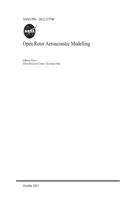
Open Rotor Aeroacoustic Modelling
Series:
Owing to their inherent fuel efficiency, there is renewed interest in developing open rotor propulsion systems that are both efficient and quiet. The major contributor to the overall noise of an open rotor system is the propulsor noise, which is produced as a result of the interaction of the airstream with the counter-rotating blades. As such, robust aeroacoustic prediction methods are an essentia
NaN
VOLUME
English
Paperback

Owing to their inherent fuel efficiency, there is renewed interest in developing open rotor propulsion systems that are both efficient and quiet. The major contributor to the overall noise of an open rotor system is the propulsor noise, which is produced as a result of the interaction of the airstream with the counter-rotating blades. As such, robust aeroacoustic prediction methods are an essential ingredient in any approach to designing low-noise open rotor systems. To that end, an effort has been underway at NASA to assess current open rotor noise prediction tools and develop new capabilities. Under this effort, high-fidelity aerodynamic simulations of a benchmark open rotor blade set were carried out and used to make noise predictions via existing NASA open rotor noise prediction codes. The results have been compared with the aerodynamic and acoustic data that were acquired for this benchmark open rotor blade set. The emphasis of this paper is on providing a summary of recent results from a NASA Glenn effort to validate an in-house open noise prediction code called LINPROP which is based on a high-blade-count asymptotic approximation to the Ffowcs-Williams Hawkings Equation. The results suggest that while predicting the absolute levels may be difficult, the noise trends are reasonably well predicted by this approach. Envia, Edmane Glenn Research Center NASA/TM-2012-217740, E-18485
Price Comparison [India]
In This Series
Bestseller Manga
Trending NEWS




















